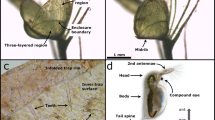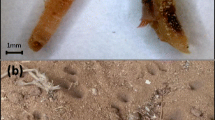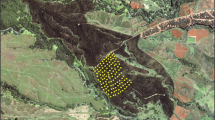Abstract
Disturbances to monitors and baits have often been noted as a confounding factor for the success of termite baiting systems. We studied escape behavior of Coptotermes formosanus Shiraki to a food source disturbance in the laboratory. Four peripheral chambers connected to the central food chamber through tubes served as escape routes from which escape patterns, escape and return times and differences in soldier and worker responses were recorded. We used two sand conditions: moist and dry to test whether favorable versus unfavorable conditions change escape behavior. The post disturbance responses were video recorded for 1 h. C. formosanus quickly escaped from the central chamber when disturbed. The time taken to reach the maximum number of termites that escaped ranged from 20 s to 210 s followed by a gradual return to the disturbed chamber. The majority of the escapees returned to the disturbed area within a few minutes after evacuation in both dry and wet sand conditions. A significantly higher percentage of termites escaped in wet sand arenas (43%) than in the dry sand arenas (31%). Our experiments demonstrate that C. formosanus is highly unlikely to abandon bait stations for extensive periods of time as a result of mechanical disturbances regardless of habitat quality.



Similar content being viewed by others
References
Campora CE, Grace JK (2007) Foraging behavior of the Formosan subterranean termite (Isoptera: Rhinotermitidae) in response to borate treated wood. International Research Group on Wood Preservation, Stockholm, Sweden. IRG Document No. IRG/WP 07–10605, 13 pp
Curl G (2004) Pumped-up termite market. Pest Contr Tech 32:26, 28, 33
Eggleton P, Bignell DE, Hauser S, Dibog L, Norgrove L, Madong B (2002) Termite diversity across an anthropogenic disturbance gradient in the humid forest zone of West Africa. Agric Ecosyst Environ 90:189–202
Fei H, Henderson G (2005) Repellency of Formosan subterranean termites (Isoptera: Rhinotermitidae) to dead termites and attraction to 2-phenoxyethanol with and without nonrepellent insecticides. J Agr Urban Entomol 23:159–172
Forschler BT, Ryder JC (1996) Subterranean termite, Reticulitermes spp. (Isoptera: Rhinotermitidae), colony response to baiting with hexaflumuron using a prototype commercial termite baiting system. J Entomol Sci 31:143–151
Gautam BK, Henderson G (2011) Effects of sand moisture level on food consumption and distribution of Formosan subterranean termites (Isoptera: Rhinotermitidae) with different soldier proportions. J Entomol Sci 46:1–13
Grace JK, Tome CHM, Shelton TG, Oshiro RJ (1996) Baiting studies and considerations with Coptotermes formosanus (Isoptera: Rhinotermitidae) in Hawaii. Sociobiology 28:511–520
Henderson G (2001) Practical considerations of the Formosan subterranean termite in Louisiana: a 50-year-old problem. Sociobiology 37:281–392
Hu XP, Appel AG, Traniello JFA (2003) Behavioral response of two subterranean termites (Isoptera: Rhinotermitidae) to vibrational stimuli. J Insect Behav 16:703–715
Lewis VR (1997) Alternative control strategies for termites. J Agr Entomol 14:291–307
Nagendra N, Gautam BK, Henderson G (2010) Effects of oil-based paint marking on the foraging behavior of Formosan subterranean termites (Isoptera: Rhinotermitidae). Sociobiology 55:369–378
Noirot C, Darlington JPEC (2000) Termite nests: architecture, regulation and defense. In: Abe T, Bignell DE, Higashi M (eds) Termites: evolution, sociality, symbioses, ecology. Kluwer Academic, Dordrecht, pp 121–139
Pawson BM, Gold RE (1996) Evaluation of baits for termites (Isoptera: Rhinotermitidae) in Texas. Sociobiology 28:485–510
Reinhard J, Clement J-L (2002) Alarm reaction of European Reticulitermes termites to soldier head capsule volatiles (Isoptera: Rhinotermitidae). J Insect Behav 15:95–107
Schwinghammer MA, Houseman RM (2006) Response of Reticulitermes flavipes (Isoptera: Rhinotermitidae) to disturbance in laboratory arenas at different temperatures and soldier proportions. J Econ Entomol 99:462–468
Stuart AM (1963) Studies on the communication of alarm in the termite Zootermopsis nevadensis (Hagen), Isoptera. Physiol Zool 36:85–96
Stuart AM (1967) Alarm, defense, and construction behavior relationships in termites (Isoptera). Science 156:1123–1125
Su N-Y, Scheffrahn RH (1990) Economically important termites in the United States and their control. Sociobiology 17:77–94
Su N-Y, Scheffrahn RH (1996) A review of the evaluation criteria of bait-toxicant efficacy against field colonies of subterranean termites (Isoptera). Sociobiology 28:521–530
Su N-Y, Scheffrahn RH (1998) A review of subterranean termite control practices and prospects for integrated pest management programs. Integrated Pest Manag Rev 3:1–3
Su N-Y, Tamashiro M, Yates JR, Haverty MI (1982) Effect of behavior on the evaluation of insecticides for prevention of or remedial control of the Formosan subterranean termite. J Econ Entomol 75:188–193
Traniello JFA, Thorne BL (1994) Termite baits in theory and practice. In: Robinson WH (ed) Proceedings of the National Conference on Urban Entomology, 20–22 February, Atlanta, GA, pp 28–40
Wong N, Lee C-Y (2010) Effects of disturbance and the presence of termite and other invertebrate carcasses at feeding sites on the behavior of the subterranean termites Microcerotermes crassus (Isoptera: Termitidae). Sociobiology 55:353–367
Woodrow RJ, Shelton TG, Oshiro RJ, Grace JK, Wagner TL (2008) Effects of disturbance-induced trauma on foraging by subterranean termites (Isoptera: Rhinotermitidae). Sociobiology 52:107–118
Acknowledgments
We sincerely thank Yanxi Liu for helping in the experimental set up, video recording and manually recording of the data. We are very thankful to Louisiana Department of Agriculture and Forestry for providing partial fund for this study. This manuscript is approved for publication by the Director of the Louisiana Agricultural Experiment Station as manuscript no. 2011-234-6253.
Author information
Authors and Affiliations
Corresponding author
Rights and permissions
About this article
Cite this article
Gautam, B.K., Henderson, G. Escape Behavior of the Formosan Subterranean Termite (Isoptera: Rhinotermitidae) in Response to Disturbance. J Insect Behav 25, 70–79 (2012). https://doi.org/10.1007/s10905-011-9278-4
Revised:
Accepted:
Published:
Issue Date:
DOI: https://doi.org/10.1007/s10905-011-9278-4




